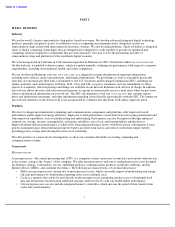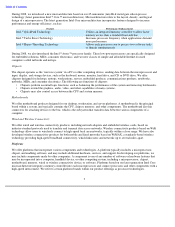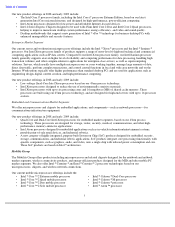Intel 2008 Annual Report Download - page 15
Download and view the complete annual report
Please find page 15 of the 2008 Intel annual report below. You can navigate through the pages in the report by either clicking on the pages listed below, or by using the keyword search tool below to find specific information within the annual report.
Table of Contents
Distribution
Typically, distributors handle a wide variety of products, including those that compete with our products, and fill orders for
many customers. We also utilize third-party sales representatives who generally do not offer directly competitive products but
may carry complementary items manufactured by others. Sales representatives do not maintain a product inventory; instead,
their customers place orders directly with us or through distributors.
Backlog
We do not believe that backlog as of any particular date is meaningful, as our sales are made primarily pursuant to standard
purchase orders for delivery of products. Only a small portion of our orders is non-cancelable, and the dollar amount
associated with the non-cancelable portion is not significant.
Seasonal Trends
Our microprocessor sales generally have followed a seasonal trend. Historically, our sales have been higher in the second half
of the year than in the first half of the year. Consumer purchases of PCs have historically been higher in the second half of the
year, primarily due to back
-to-
school and holiday demand. In addition, purchases from businesses have also historically tended
to be higher in the second half of the year. This seasonal trend did not occur in 2008, and there can be no assurance that it will
resume in the future.
Marketing
Our corporate marketing objectives are to build a strong Intel corporate brand that connects with consumers, and have a
limited set of product brands for our advanced microprocessors and related technologies. Our intention is to have a limited
number of meaningful and valuable brands in our portfolio to aid in making informed choices and making technology
purchase decisions easier for both businesses and consumers. The Intel Core i7, Intel Core 2 Extreme, Intel Core 2 Quad, Intel
Core 2 Duo, Intel Atom, Pentium, Celeron, Intel Xeon, and Itanium trademarks make up our processor brands.
Microprocessors are at the center of our most advanced processor technologies, which include Intel Centrino processor
technology and Intel Core 2 processors with vPro technology.
We promote brand awareness and generate demand through our own direct marketing as well as co-marketing programs. Our
direct marketing activities include television, print and web-based advertising, as well as press relations, consumer and trade
events, and industry and consumer communications. We market to consumer and business audiences, and focus on building
awareness and generating demand for increased performance, power efficiency, and new capabilities.
Purchases by customers often allow them to participate in cooperative advertising and marketing programs such as the Intel
Inside
®
Program. This program broadens the reach of our brands beyond the scope of our own direct advertising. Through the
Intel Inside Program, certain customers are licensed to place Intel logos on computers containing our microprocessors and
processor technologies, and to use our brands in marketing activities. The program includes a market development component
that accrues funds based on purchases and partially reimburses the OEMs for marketing activities for products featuring Intel
brands, subject to the OEMs meeting defined criteria. These marketing activities primarily include television, web-based
marketing, and print; and in the beginning of 2008, we increased our focus on web-
based marketing. We have also entered into
joint marketing arrangements with certain customers.
Competition
The semiconductor industry is dynamic, characterized by rapid advances in technology and frequent product introductions. As
unit volumes of a product grow, production experience is accumulated and costs typically decrease, further competition
develops, and prices decline. The life cycle of our products is very short, sometimes less than a year. These short product life
cycles and other factors lead to frequent negotiations with our OEM customers, which typically are large, sophisticated buyers
who are also operating in very competitive environments. Our ability to compete depends on our ability to navigate this
environment, by improving our products and processes faster than our competitors, anticipating changing customer
requirements, developing and launching new products and platforms, pricing our products competitively, and reducing average
unit costs. See “Risk Factors” in Part I, Item 1A of this Form 10-K.
10
























